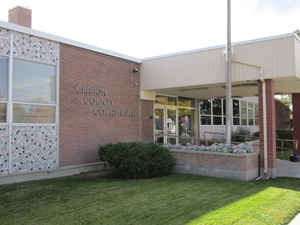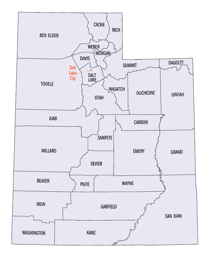Utah Counties
There are twenty-nine counties in the State of Utah. There were originally seven counties established under the provisional State of Deseret in 1849: Davis, Iron, Sanpete, Salt Lake, Tooele, Utah, and Weber. The Territory of Utah was created in 1851 with the first territorial legislature meeting from 1851-1852. The first legislature re-created the original counties from the State of Deseret under territorial law as well as establishing three additional counties: Juab, Millard, and Washington. All other counties were established between 1854 and 1894 by the Utah Territorial Legislature under territorial law except for the last two counties formed, Daggett and Duchesne.Carbon County, Utah
Carbon County Education, Geography, and History

Carbon County is a county located in the state of Utah. Based on the 2010 census, the population was 21,403. Its county seat and largest
city is Price. The county is named for the major coal deposits in the area.
The Price, UT Micropolitan Statistical Area includes all of Carbon County.
Etymology - Origin of Carbon County Name
from the vast amounts of coal found there
Demographics:
County QuickFacts: CensusBureau Quick Facts
Carbon County History
Most of Carbon County's residents live in the Price River Valley and at the foot of the Book Cliffs. The western end of the county rises to the Wasatch Plateau and slopes down eastward to the Price River which cuts through Castle Valley. This valley stretches across the southern half of Carbon into Emery County, with the Wasatch Plateau on the north and west and the Book Cliffs all along the east. The Green River marks the eastern border of the county. Geographically, Carbon County is in the Colorado Plateau physiographic province. Evidence of the Fremont Culture is extensive in the county. Figurines have been discovered as well as many rock art panels, such as the "Head Hunter" located in the Gordon Creek area. Evidence of prehistoric life includes many dinosaur footprints found in coal mines. Mormon settlements were established all along the Price River in the late 1870s. The high barrier of the Wasatch Plateau had delayed settlement until that time. Routes into the region included offshoots of the Old Spanish Trail and a trail over Soldier Summit. Farming and ranching became early economic activities, giving Carbon County a tradition of cowboys and outlaws, with the likes of Butch Cassidy and Gunplay Maxwell roaming the area. The Nine Mile Canyon freight road from Price to the Uinta Basin became an important transportation link. In 1894 the territorial legislature separated Carbon County from Emery County.During the early 1880s the Denver and Rio Grande Western Railroad, seeking a route from Denver to Salt Lake City, discovered and opened up the vast coal lands of Carbon County. Coal mining became the major catalyst for development. Coal companies often built and ran towns in Carbon and imported many southern and eastern European and Japanese laborers to work in the coal mines and on railroad gangs. Helper became known as the town of "57 Varieties" because of its ethnic diversity. Mine explosions near Scofield in 1900 (200 killed) and at Castle Gate in 1924 (172 killed) and major strikes in 1903-4, 1922, and 1933 brought tragedy, violence, and eventual unionization to the mines. Coal mining continues to play a vital role in economic and social development, with ups and downs in the industry creating periods of boom and relative bust. Utah Power and Light built a main electric generating plant near the former town of Castle Gate. In 1980 the Carbon Plant generated 171 megawatts of electricity. Ninety-eight percent of UP&L's power comes from thermal steam plants that burn coal. The College of Eastern Utah, established in 1937 in Price, promises to become a more important facet of the county's economic and social development in the future.
Source: Beehive History 14: Utah Counties. 1988. Utah State Historical
Society, 300 Rio Grande, Salt Lake City, UT 84101-1182.
Geography: Land and Water
As reported by the Census Bureau, the county has a total area of 1,485 square miles (3,845 km2), of which,
1,478 square miles (3,829 km2) of it is land and 6 square miles (16 km2) of it (0.41%) is water.
Neighboring Counties
Bordering counties are as follows:
- Utah County, Utah - (northwest)
- Duchesne County, Utah - (north)
- Emery County, Utah - (south)
- Uintah County, Utah - (east)
- Sanpete County, Utah - (west)
- Grand County, Utah - (southeast)
Education







